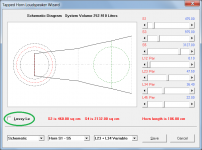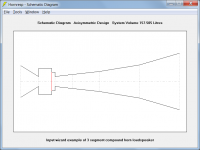Hi Josh,
Prepare to be amazed 🙂.
Your requested enhancement will be included in the next release (provided that we can settle on a meaningful name for the Loudspeaker Wizard checkbox before then). You mentioned long Xmax drivers - Would "Large Xmax" be a suitable title, or is the tool also used with drivers that do not have an overly significant excursion?
Kind regards,
David
Dave,
You are the man. Thank you.
I believe this tweak is useful for all drivers. If it is tried on tweeters or small midranges you'll often find that the changes are miniscule. The changes are largest on big subwoofer drivers with a high normalized inductance. Drivers without shorting rings, very long coil winds, many layer coils, big motors with a lot of steel in and around the gap, high moving mass and /or low motor force, so it is more useful in those cases. However it seems to be closer to matching measurements for all drivers with it applied. I would lean towards calling it "Lossy LE" or similar.
Kolbrek Thank you very much...
One doubt if N=Kg*m/s^2 how can it be that N*s/m=Kg? It should be N*s^2/m or not?
One doubt if N=Kg*m/s^2 how can it be that N*s/m=Kg? It should be N*s^2/m or not?
SWAG
Leach Effect Perhaps? WHG
Hi Josh,
Prepare to be amazed 🙂.
Your requested enhancement will be included in the next release (provided that we can settle on a meaningful name for the Loudspeaker Wizard checkbox before then). You mentioned long Xmax drivers - Would "Large Xmax" be a suitable title, or is the tool also used with drivers that do not have an overly significant excursion?
Kind regards,
David
Leach Effect Perhaps? WHG
Attachments
Leach Effect Perhaps? WHG
Thanks for that paper Bill. I didn't have that one. Makes my head hurt to read it. But third or fourth read it will start to make sense😀
More
Follow-On Papers
Thanks for that paper Bill. I didn't have that one. Makes my head hurt to read it. But third or fourth read it will start to make sense😀
Follow-On Papers
Attachments
How do you decide if the tool should be used on a particular driver? What physical or electrical specifications do you consider when making the decision?
Incidentally - it's good to hear from you again 🙂.
Kind regards,
David
Yeah, nice to chat again.
My old cutoff point was Le/Re=1. And really any driver that looks beefy and/or has very high power handling. I was certainly not aware that the adjustment makes all sims for all drivers more accurate, I haven't even thought that might be the case although it does make sense as the adjustment formula is based on a log curve based on advice from you and LTD02 so there's vastly diminishing issues with moderate or lower Le/Re. Thanks very much to Ricci for pointing this out. I'm incredibly busy now so it might be quite awhile before I can run some sims on some of the pro driver measurements on data-bass.
I also agree with Ricci that the checkbox should be called "Lossy Le". At the time I did the study and wrote the paper I was well aware of lossy inductance but I wasn't sure it was the main culprit here. It always should have been called Lossy Le.
Last edited:
how can it be that N*s/m=Kg?
Hi Rotsen,
It doesn't 🙂.
Rms = N * s / m = Kg / s
Given
F = m * a
Then
1 N = 1 Kg * m / (s ^ 2)
Multiply both sides by s / m
1 N * s / m = 1 Kg / s
Kind regards,
David
Hi Josh and JAG,
Thanks for the feedback. Even though we adjust Bl rather than inductance, "Lossy Le" it will be 🙂.
Until I read your comments about all drivers, I thought that perhaps "Large motor" might be an appropriate term to use since it relates to both voice coil and magnet, and to the Bl parameter, and implies that the driver will be physically relatively large and "powerful", making it easier for the uninitiated user to identify suitable candidate drivers.
Kind regards,
David
Thanks for the feedback. Even though we adjust Bl rather than inductance, "Lossy Le" it will be 🙂.
Until I read your comments about all drivers, I thought that perhaps "Large motor" might be an appropriate term to use since it relates to both voice coil and magnet, and to the Bl parameter, and implies that the driver will be physically relatively large and "powerful", making it easier for the uninitiated user to identify suitable candidate drivers.
Kind regards,
David
Attachments
I agree, Large Motor seems more understandable by a large amount of people compared to Lossy Le. Especially if there is more than one parameter involved.
To add a note, sometimes it looses the check if you go out and back in. That's pretty annoying. Can the check be remembered so you do not need to check it every time.
To add a note, sometimes it looses the check if you go out and back in. That's pretty annoying. Can the check be remembered so you do not need to check it every time.
Last edited:
Hi jayam000,
The system you show should be modelled as a compound (CH) horn, as shown in the attachment.
Kind regards,
David
Hello david
Do I understand correctly?
Attachments
Hi jayam000,
The system you show should be modelled as a compound (CH) horn, as shown in the attachment.
Kind regards,
David
Thanks you very much.
I will try this way.
Hi Josh and JAG,
Thanks for the feedback. Even though we adjust Bl rather than inductance, "Lossy Le" it will be 🙂.
Until I read your comments about all drivers, I thought that perhaps "Large motor" might be an appropriate term to use since it relates to both voice coil and magnet, and to the Bl parameter, and implies that the driver will be physically relatively large and "powerful", making it easier for the uninitiated user to identify suitable candidate drivers.
Kind regards,
David
"Large Motor" is pretty much the same as "Large Coil", in fact I was originally thinking of calling it the "Large Coil and Motor adjustment" but that was too wordy.
The purpose of the adjustment is simply to get a more accurate sim, the culprit for the accuracy issue is lossy inductance. It's Bl that we've shown can be adjusted to make the sim more accurate but that's because the lossy inductance issue presents as a weaker motor than the t/s specs would suggest. So the whole issue is about inductance, Bl being the adjustment parameter is just a consequence. So I don't think the checkbox title should reference Bl. It should just be called "Lossy Le" or "Lossy Inductance".
If you want to reference Bl and make it stand out to indicate that Bl is the moving parameter here, like I said, maybe just put a Bl = X in red in the place where you put the sealed box qtc in the wizard.
Those are my thoughts but I'm certainly open to discussion.
Don't the sims also get more accurate if you use the measured minimum AC resistance (the one above resonance) rather than the D.C. Resistance for Re? This tends to reduce the "effective" BL.
Hi USRFobiwan,
It seems that "Lossy Le" is the more technically correct term to use. I will try to make it clear in the Help file though, that the feature is primarily intended to be used with drivers having large motors.
The check box setting will be retained in the next update, and will also be automatically transferred to the main input form. It will also be possible to select the option directly from the main input form rather than having to use the Loudspeaker Wizard, and to permanently save the setting to the data record if so desired.
Kind regards,
David
Large Motor seems more understandable by a large amount of people compared to Lossy Le.
It seems that "Lossy Le" is the more technically correct term to use. I will try to make it clear in the Help file though, that the feature is primarily intended to be used with drivers having large motors.
To add a note, sometimes it looses the check if you go out and back in.
The check box setting will be retained in the next update, and will also be automatically transferred to the main input form. It will also be possible to select the option directly from the main input form rather than having to use the Loudspeaker Wizard, and to permanently save the setting to the data record if so desired.
Kind regards,
David
Hello david
Do I understand correctly?
Hi Piyapong38,
Yes, you do 🙂.
Kind regards,
David
Thanks you very much.
I will try this way.
Hi jayam000,
You can of course use up to three segments, plus a throat adaptor, to specify the bifurcated folded horn.
Kind regards,
David
Attachments
The check box setting will be retained in the next update, and will also be automatically transferred to the main input form. It will also be possible to select the option directly from the main input form rather than having to use the Loudspeaker Wizard, and to permanently save the setting to the data record if so desired.
Kind regards,
David
Just wondering - will we be able to see the new value of Bl?
Hi jayam000,
You can of course use up to three segments, plus a throat adaptor, to specify the bifurcated folded horn.
Kind regards,
David
Thank you very very much.
Hi Piyapong38,
Yes, you do 🙂.
Kind regards,
David
I forgot to add that for systems like the one shown, the air volume in front of the driver cone is also normally included in the value for Vtc.
- Home
- Loudspeakers
- Subwoofers
- Hornresp



